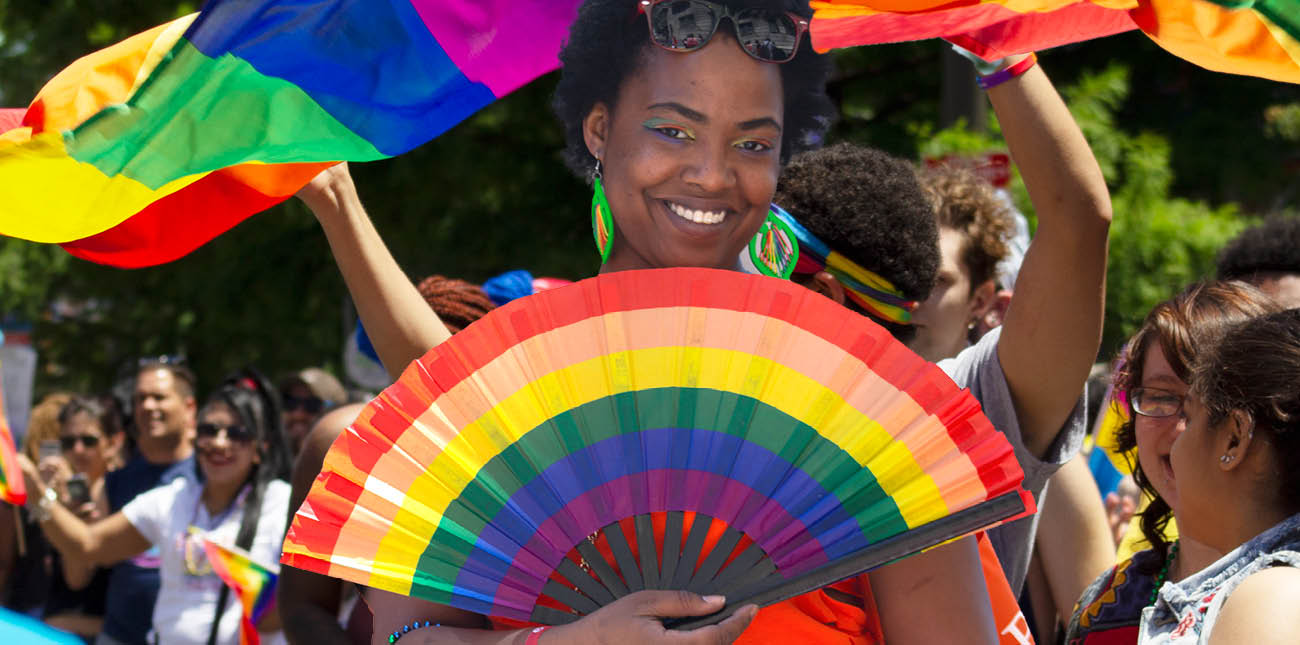
LGBTQ + and of color: a battle on two fronts
This month of June we recognize and ratify once again our commitment to the LGBTQ+ community, on whose shoulders today we celebrate the pride of being Latinx.
“As a lesbian, I have no face,” said Gloria E. Anzaldúa, “my own people disclaim me; but I am all races because there is the queer of me in all races.”
Anzaldúa is one of the hundreds of Latino voices that joined the LGBTQ revolution during much of the 20th century, and who fought tirelessly against the stigma, criminalization, and exclusion of those who refuse to adapt to rigid and outdated cultural frameworks.
There are still those who believe that the diversity of gender, sexual preference and lifestyle is an invention that came hand in hand with the sexual revolution of the 60s.
This could not be farther from the truth.
What actually began at that time was a movement tired of having to fight for their right to exist, to live and love. It was a challenge that brought to the streets a sense of community that today defines all of us who are represented by the acronym LGBTQ+ with one word: pride.
History has cataloged us with derogatory terms, from sodomites to pedophiles, defining us as something less than a human being
History has cataloged us - from sodomites to pedophiles - as something less than a human being with full rights, and even when science has sided with its standard-bearer logic, the struggle continues.
What if you are a person of color? Well, the battle is twice as hard.
Few people could recognize the symbolic weight of Jack "Babe Bean" Garland or Amelio Robles, two transgender Hispanics of Mexican origin who decided to live their identity as they felt at the end of the 19th century (yes, of the 19th century); or the importance of Gonzalo "Tony" Segura and José Sarria in the activism of the 50s and 60s for the rights of the LGBTQ+ community.
These are just a few of the names of the Latinx who have been there since the beginning of the LGBTQ+ rights movement.

During 2017, Netflix brought to light the story of Marsha P. Johnson, an activist for the rights of transgender individuals in the United States, and a key figure in the Stonewall revolts in 1969.
After the first 20 minutes of the documentary, the story turns its attention to Sylvia Rivera and intertwines the trajectories of both women, since one could not have existed without the other – a relationship which serves as a perfect analogy of the history of the community in the nation.
Daughter of Puerto Rican and Venezuelan immigrants, Rivera represents the reality lived by millions of Latinx in the country

Born and raised in New York City, and the daughter of Puerto Rican and Venezuelan immigrants, Rivera represents the reality lived by millions of Latinx in the country: poverty, misery, addiction, violence, abandonment, and perennial governmental oversight.
In her case, these elements became the force behind movements such as the Civil Rights Movement, the revolts against the Vietnam War, the feminist revolution and, finally, the Street Transvestite Action Revolutionaries.
Holly Woodlawn, a Puerto Rican transgender person who acted in films by Andy Warhol, and whose legacy was the Holly Woodlawn Memorial Fund for Transgender Youth in Los Angeles, also joined Rivera’s movement. Even the Velvet Underground leader Lou Reed immortalized her in his famous song, "Walk on the Wild Side".
Simultaneously, the revolution was taking place in the university halls.
The writer, activist and academic Gloria Anzaldúa (recognized for her book Borderlands: La Frontera), led the intersectional and feminist current in literature and gender theory research, constantly speaking from her experience as a Latina and lesbian in the United States and her wide knowledge base as an academician.
In the same way, Juanita Diaz-Cotto continued her research and writing about the reality of homosexual Latina women in the country with her narrative work.
Miguel Pinero, Dolores Huerta, Vaginal Creme Davis, Ray Navarro, Pedro Zamora, Wilson Cruz, Phil Jimenez, Patricia Velasquez, Victoria Cruz, Shane Ortega, Amaranta Gomez Regalado, Orlando Cruz, Bamby Salcedo, Daniela Vega, Julio Salgado and Raffi Freedman- Gurspan, are just some warriors in this battle that seems to face a new era with ever-changing obstacles.
Even when we have managed to overcome hurdles such as the right to marry, to adopt, to work without being discriminated against, to express our opinion and to live our identity openly, we continue to face a monster with a thousand heads.
Being Latino means living at a crossroads. Hispanics, Latin Americans, Ibero-Americans ... Heritage has become a prejudice and a feature worthy of pride, at the same time.
For some years, the word "Latinx" has frequently appeared in news and social media as a transformation of the language that eliminates the traditional "o" and places under the same umbrella those who identify themselves outside the gender binary framework, including transgender people and those that consider themselves "gender-fluid.”
But this new expression goes much further.
For Hugo López, director of research on the Hispanic community at the Pew Research Center, the term Latinx is a very particular approach to the phenomenon of identity in the United States.
"Latinx fits within our broader history in the U.S. of using various terms to describe our identity," Lopez told NBC News. "It is pan-ethnic like Hispanic, and politician in a sense like Chicano."
According to the Pew Research Center, Latinos in the United States represent 17.4 percent of the total population and have become the strongest minority in the entire country.
Among them, 1.4 million are identified as members of the LGBTQ+ community; 146,000 have formed same-sex parental homes, and 29.1 percent of them are raising children.
A report by the Center for American Progress found that there are around 904,000 LGBTQ + immigrants in the United States, of whom 267,000 are undocumented.
If you have been paying attention to the news, death and abuse at the hands of the U.S. government are the daily lives of immigrants. To be, on top of that, a member of a community as vulnerable as the LGBTQ+ is another level in Dante's hell.
Since the imposition of the zero-tolerance policy of the Trump administration, at least two transgender women have died under murky circumstances and what advocates have alleged to be subparconditions while in government custody, while hundreds more are waiting across the border to apply for asylum.
After requesting asylum at the door of San Ysidro (San Diego), Roxana Hernández, a transgender immigrant from Honduras, died of cardiac arrest and complications from HIV during the month of May 2018.
However, after carrying out an independent autopsy, it was revealed that Hernández showed signs of physical abuse caused in the custody of the Immigration and Customs Enforcement agency, according to his family.
RELATED CONTENT
For her part, Camila Díaz Córdova, aged 29, died on February 3, 2019 in Soyapango (San Salvador) after the US government denied her the right to asylum and deported her.
Local doctors determined that the cause of death had been a brutal attack on the streets of the city.
Even while facing the risk that their fundamental rights could be violated once they cross into the U.S., these people prefer anything rather than return to their country, where an imminent death sentence hangs over them just for wanting to live their identity in freedom.

On November 2018, Yariel Valdés reported the aggression suffered by a group of LGBTQ+ migrants within the Caravan of Refugees that had traversed Central America, fleeing the violence in their respective countries.
Among the more than four thousand travelers - all of whom faced aggression and stigmatization from political leaders like Donald Trump - there was another group that had to suffer at the same time the rejection of their fellow travelers.
There is no more tangible example of the reality of transgender Latinx than this episode.
Valdés cites figures from the non-governmental organization Transgender Europe that place Latin America as the region with "the highest global rates of violence against the LGBTQ community."
Transgender Europe (TGEU) has determined that around 2264 trans people have been killed
Transgender Europe (TGEU) has determined that between Jan. 1, 2008, and Sept. 30, 2016, around 2,264 trans people have been murdered in the Americas; 1,768 of them perished in South and Central America.
That is to say, 78% of all homicides of transgender people worldwide are concentrated in Latin America, making evident the calcification of patriarchy and machismo in those societies.
According to a report by La Red 21, hate crimes "are characterized by their levels of cruelty, violence, and brutality," coinciding with the report of the Inter-American Commission on Human Rights (IACHR).
Lapidating, beheadings, burnings, genital mutilation and other types of pathological violence are challenges in the daily life of transgender Latinx individuals.
Despite efforts for greater visibility and the demand for human rights in the Latinx community, the situation seems to have worsened, especially due to the emergence of new digital platforms that have given rise to "cyberbullying."
To have a clearer idea, the first LGBTQ+ march against homophobia and transphobia in Mexico took place in 1978, and the organization of efforts to protect and recognize gender identity in this country has grown exponentially.
However, today, Mexico is the most dangerous country for anyone whose identity is not framed within heteronormativity.
According to Animal Político, "between 1995 and 2016, the civil association Letra S documented 1,310 hate murders," of which 265 (20.2%) corresponded to transgender people.
Despite these figures, the transgender community in Latin America has had its moments of glory.
Accomplishments such as those of Daniela Vega (first transgenderwoman to present the Oscar awards), or Tamara Adrián (the first transgender person to reach a position in the National Assembly of Venezuela, and second to reach a national legislature in the Western Hemisphere), have shown that there is an opportunity for equal rights in Latin America, even if it’s still a "caravan" full of obstacles.
Therefore, and more so, this year, when the historic uprising at Stonewall marks its 50th anniversary, it is more important than ever to make the strength and voice of our community felt, across all boundaries and borders of identity and country.











LEAVE A COMMENT: